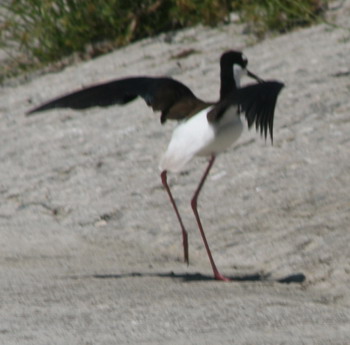Down by the river everybody is busy hatching the new families. Some black-necked stilts were quite fast this year; their tiny little fluff balls are already out and about. As every year the parent birds are on high alert: Anything larger than a stilt is a potential danger to the chicks.
What do black-necked stilts (being rather small and fragile birds) do to protect their young as long as they can’t fly? As soon as the parent birds see anything dangerous approaching, they start to lure the assumed predator away.
Hey, I am here. HERE!

Look, something is wrong with me.

I can’t fly.

My legs are giving up.

I’m done – broken wing, can’t run any more.

If the assumed predator now approaches the stilt, the bird musters up the last remnants of strength to fly again. Not very far, then it has to land again… that wing, you know… just a bit farther away from the spot where the little ones are hiding. This game continues until the stilt calculates that the distance to the hiding place is long enough – end of operation, miracle cure, the stilt flies away and returns to the spot where the chicks are safely tucked away, in a nice grass thicket or such. There the other parent joins in to give the “all clear” signal.

# 1 has left cover.

# 2 made it safely back too – hurray, the family is united again.

What a wonderful series of photographs. You capture so well the whole protective scheme. It’s just amazing how clever wildlife can be. Having no teeth or claws, the bird still finds a way to keep harm from its young.
We just love the stilts, they are our favorite birds. This sequence was one of the more harmless type; we’ve been down there when the eggs were still in the nest – then one of the parent birds stays with the eggs, while the other one dive-bombs.
Admittedly, they never make contact, but with those beaks one does feel a bit uncomfortable when one of the birds sweeps over your head only 3 feet away.
Mockingbirds do that too. I have seen them harass cats unmercifully – and they do give the cats a sharp rap on the rear quarters sometimes.
Yes, they do. We have the most amazing “Star Wars’ going on here – mockingbirds driving out crows and red-tailed hawks.
Just the other day we saw a hawk hot-winging it – with a mockingbird attached to its tail feathers!
No kidding – that mockingbird had a lot of spunk and apparently really, really did hate hawks.
Last summer we rescued a young mockingbird out of our carport. We assumed it would take another week until it could really fly, so we put the young one into the garden, under cover, as we were not sure whether it would survive inside the house.* Overhead on the power lines the complete extended family was keeping watch and they did feed the chick on the ground + they attacked the neighborhood cats out on the prowl for a juicy bit of mock wing.
We are pretty sure the nest hopper survived and flew off a few days later.
*It is not unusual for young mockingbirds to fall out of the nest and it is known that the parent birds take care of their offspring while “grounded.”
That’s funny!
On my daily walk I have a quail that does that to me every day!!
Great photos!
Yes, it is amusing for us – for the birds it might seem different. I always try to respect that; that’s the reason why I stayed far away from the little family when they gathered their young ones again (as one can see from the format of the photos).
I didn’t know that about mockingbirds taking care of fallen nest babies. It’s always so distressing to find a baby bird on the ground.
We once had a big old cat named Beau. I watched one day as he perched precariously on the top bar of our chain link fence. A mockingbird began attacking him, and delivered some sharp pecks to his hindquarters. The cat couldn’t raise a paw to swat at the bird because the cat couldn’t balance three-legged on the fence. He finally jumped down off the fence and ran to hide in a flower bed. I imagine the cat had it coming. He’d probably slain numerous of the bird’s relatives.